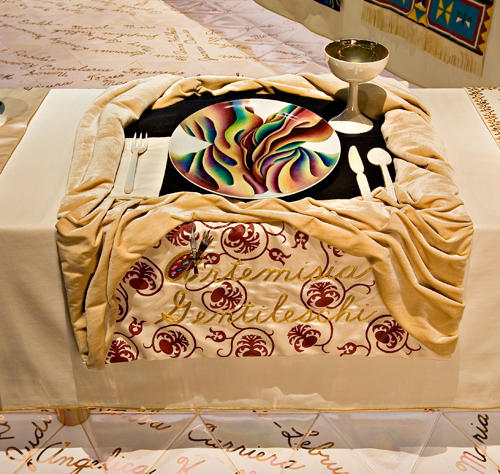Artemisia Gentileschi
- Romina Rosso

- Dec 20, 2020
- 7 min read
Updated: Apr 10, 2021

National Gallery- London
3 October 2020 - 24 January 2021
The National Gallery delivered the first major exhibition in UK devoted to an historical female artist, Artemisia Gentileschi.
This astonishing exhibition is presenting some of the masterpieces of Artemisia, that show to the public her great ability and skills as an exceptional artist with an important career developed in different cities: Rome, Florence, Venice, Naples and London.
For many years, she was under the shadow of Caravaggio, and her famous father, Orazio Gentileschi.
Her talent was recognised during her lifetime, but was then largely forgotten until the late 20th Century.
In the 1976, at a time when the Feminist Art Movement was gaining in support and momentum, Artemisia’s works were included in the first international art exhibition made up entirely of art created by professional female artists. The exhibition was curated by Professors Ann Sutherland Harris and Linda Nochlin and included eighty-three artists from twelve countries.
Artemisia became the symbol of the women’s capacity of overcome life struggles with courageous creativity.
Artemisia’s name was also placed in the installation The Dinner Party (1974-79) by feminist artist Judy Chicago, widely regarded as the first epic feminist artwork, it functions as a symbolic history of women in civilization.
Italian women artists from 16th- and 17th-century increased their popularity in the last years, with an exhibition devoted to Sofonisba Anguissola and Lavinia Fontana at the Prado last year, and another last spring in Florence of works by Giovanna Garzoni. Our view of Artemisia Gentileschi is also at a turning point, with rediscoveries of both paintings and documents changing our view of her significance.
One of the highlights in the exhibition is a newly rediscovered work by Artemisia purchased by the National Gallery in 2018: Her Self-Portrait as St. Catherine of Alexandria (around 1615-17).
The National Gallery director Gabriele Finaldi about Artemisia said: "In a world of 17th Century art which was dominated by men patrons and men artists, Artemisia found a way to have her own voice heard, to have success and autonomous success on her own, and she achieved that through extraordinary talent, extraordinary invention but also through very clever connections with patrons and with supporters."
The first room of the exhibition included some of her early works such as Danae, Cleopatra but the masterpiece that catch all the attention is a work that she painted and signed when she was just 17 years old, Susanna and the Elders.

The Biblical story of the two old creeps trying to scare a bathing Susanna into sexual favours was a common theme during the Renaissance but Artemisia's spin on the work is unique.
Other artists of the time took the story as a way to depict a nude young woman, but Gentileschi was interested in the psychological element of the tale. There's a real sense of intrusion in the work.
Susanna looks genuinely horrified by the old men invading her privacy. Her body is twisted into an uncomfortable position, not fixed into any sort of eroticized position for the viewer. The viewer meant to identify with her in this situation, not the men.
Artemisia was born in Rome in 1593, she lost her mother when she was 12 years old, and her father Orazio Lomi Gentileschi, also a painter, began training her when she was 16.
In 1611, Orazio was working with another painter Agostino Tassi to decorate Palazzo Pallavicini-Rospigliosi in Rome.
One day in May, Tassi visited the Orazio household and, when alone with Artemisia, raped her.
Orazio accused Agostino Tassi, of raping Artemisia and a trial held in 1612 by the Pope’s court.
In the exhibition is possible to see the original transcript of the trial and it reports how Artemisia voluntarily underwent torture to prove she had not invented Tassi’s monstrous attack.
At the end of the trial Tassi was convicted to be exiled from Rome, although the sentence was never carried out.
It is a traumatic experience that has come to define Artemisia Gentileschi as an artist and a historical figure.
A month after the trial, Orazio arranged for his daughter to marry Pierantonio Stiattesi, a modest artist from Florence. Shortly afterward the couple moved to Florence.
The six years spent in Florence would be decisive for both her family life and professional career.
Artemisia gave birth to five children, although only Prudenzia survived into adulthood, and she became a successful court painter signing her works as Artemisia Lomi.
She widened her education and exposure to the arts and she was the first woman accepted into the Accademia delle Arti del Disegno (Academy of the Arts of Drawing). This allowed her to meet the most respect artists of here time, to win the favour and the protection of influential people and to became acquittance with famous people as Galileo Galilei or Michelangelo Buonarroti the Younger.
In this period possibly to avoid the inconvenience and the expenses of hiring models and to promote herself she realised several self-portraits as Self-Portrait as a Female Martyr, Self-Portrait as a Lute Player and recent acquisition of the National Gallery Self-Portrait as St. Catherine of Alexandria.


Artemisia understood that the representation of biblical or mythological figures in contemporary dress was an essential feature of the spectacle of courtly life. These subjects were not new for the period but the strength, the passion and the vulnerability of her heroines depicted with physical realism, deep psychological analysis and female point of view are unique. The collectors were sensitive to the charm of this famous female painter, they were attracted to her works full of violence and female nudes because they were painting by a woman. This is an advantage that she was well aware.
Her mastery of composition, colour and line are first class and she was one of the greatest storytellers of her time with the ability to catch the intimacy of her main characters, giving strong emotions and actions that can amaze and shock the viewers.
In this beautiful room some of her Florentine masterpieces are showing together as the two version of Judith Beheading Holofernes (Museo e Real Bosco Capodimonte Naples and Galleria degli Uffizi Florence) and Judith and her Maidservant (Palazzo Pitti- Florence).
Both Artemisia’s Judith Beheading Holofernes are works of shockingly graphic violence. It is not only the brutal detail of the decapitation but the practicalities and the physical effort involved in this task by the two women, and the details of the blood splashing in the bed sheet and in the beautiful dress of Judith.


The three figures are highly sophisticated, as is her use of chiaroscuro, the exaggerated contrast between light and shade, that add to this the drama and atmosphere she conveys in pictures that present the female protagonist in a new light: independent, powerful and determined.

In Judith and her Maidservant with the head of Holofernes in a basket is based on an earlier work by the artist's father but Artemisia gave more pathos and drama also in the small details as the pommel of the sword where you can see a face shouting in pain to remind the brutal death of Holofernes.
She left Florence for Rome and after Venice when, at the age of 37, she fled the city to avoid an exceptionally virulent outbreak of the plague.
She travelled south to Naples, at the time the largest city in Italy, second only to Paris in Europe, and part of the Spanish Empire, probably invited by the Duke of Alcalá, Fernando Enriquez Afan de Ribera, viceroy of Naples.
The opportunities for the artists in Naples were plentiful and this large scale as the altarpiece Annunciation (Annunciazione di Capodimonte), Artemisia’s first known commission for such work, was probably painted shortly after her arrival and it was signed as Artemisia Gentileschi.
Artemisia’s work was in such demand that she was able to set up and run her own workshop with great success. Her daughter, Prudenzia, also a painter, may have been among her workshop assistants.
In Naples she wrote important group of letters to the Sicilian nobleman and collector Don Antonio Ruffo in which she defends the value and the importance of her job: “I will show Your Illustrious Lordship what a woman can do” and in another letter “with me Your Lordship will not lose and you will find the spirit of Caesar in the soul of a woman”.
In Naples she had a lot of public and private commissions in large scale as the Birth of Saint John the Baptist (for the King of Spain), Lot and his daughters, Bathsheba bathing, Judith and her Maidservant with the Head of Holofernes and Susanna and the Elders.

In these paintings Artemisia again demonstrates her ability to adapt to the novelties and style of the period, to handle different subjects, to recreate in a different way subjects that she painted several times but with a new point of view and creativity. Many of these paintings were collaborations: she used specialist to complete part of the paintings such as architecture and landscape.
The last room of the exhibition is about her English period. In 1638, Artemisia was invited by Charles I to London and she joined her father Orazio, who had become court painter of Queen Henrietta Maria and received the important job of decorating a ceiling allegory of Triumph of Peace and the Arts in the Queen's House, Greenwich (now in Marlborough House). The curator placed together Joseph and Potiphar's Wife by Orazio and Esther beforeAhasuerus by Artemisia showing the connections and the differences between them with Orazio pure and perfect in the lines but static and Artemisia vigorous, dramatic, and full of drama.


The exhibition ended with her beautiful Self-Portrait as the Allegory of Painting (Royal Collection). She shows herself at work, her paintbrush poised in mid-air, in the other hand the palette, wearing a brown apron over her fine green silk dress with the sleeves rolled up to show muscular forearms. The lively brushwork reflects the energy of the inspired painter at work. The artist leans on a stone slab used for griding pigments, on which is her signature A.G and F. for fecit (made). She followed the Ripa’s rules of Iconolgia depicting the Allegory of painting as a young woman with black hair and a chain with a mask, symbol of imitation.
In this portrait Artemisia fused two visual traditions, that of the artist’s self-portrait and the allegory of Pittura, something that only a female artist could do.
Artemisia Gentileschi was a uniquely gifted artist and the National Gallery with this exquisite exhibition is giving her the right place among the all-time greatest painters.





























Yorumlar